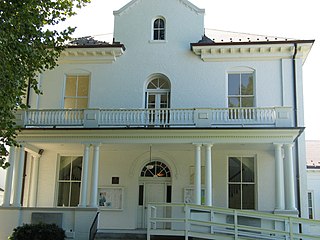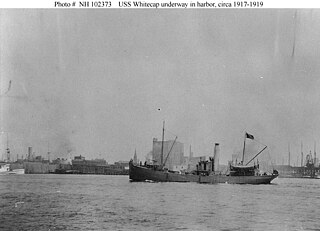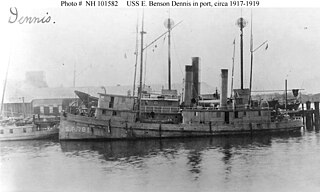
Northumberland County is a county located in the Commonwealth of Virginia. At the 2020 census, the population was 11,839. Its county seat is Heathsville. The county is located on the Northern Neck and is part of the Northern Neck George Washington Birthplace AVA winemaking appellation.

The P.V. type minesweeping trawlers were seven Royal Canadian Navy minesweeping trawlers built before the First World War in the United States. Initially constructed and used as menhaden trawlers they were taken into service the Royal Canadian Navy during the First World War for patrol duty along the Atlantic coast. Following the war they were returned to their original service.

Reedville is an unincorporated community in Northumberland County in the Northern Neck region of the U.S. state of Virginia. It is located at the eastern terminus of U.S. Route 360 east of Heathsville, at the head of Cockrell's Creek on the western shore of the Chesapeake Bay.

Reedville Fishermen's Museum is located in the unincorporated town of Reedville along the western shore of the Chesapeake Bay in Northumberland County, Virginia.

Naval trawlers are vessels built along the lines of a fishing trawler but fitted out for naval purposes; they were widely used during the First and Second World Wars. Some—known in the Royal Navy as "Admiralty trawlers"— were purpose-built to naval specifications, others adapted from civilian use. Fishing trawlers were particularly suited for many naval requirements because they were robust vessels designed to work heavy trawls in all types of weather, and had large clear working decks. A minesweeper could be created by replacing the trawl with a mine sweep. Adding depth charge racks on the deck, ASDIC sonar below, and a 3-inch (76 mm) or 4-inch (102 mm) gun in the bow equipped the trawler for anti-submarine duties.

USAT Thomas H. Barry, formerly SS Oriente, was a Ward Line ocean liner that became a United States Army troopship in the Second World War. She was intended for transfer to the United States Navy and assigned the hull number AP-45, but was not transferred and remained with the Army.

USS James (SP-429) — also known as USS W. T. James (SP-429) — was a steam trawler acquired by the United States Navy during World War I. She was converted into an armed minesweeper and assigned to the European Theater, where she performed varied tasks, including minesweeping, patrolling, and escorting of larger ships in convoy. In 1919, while returning to the United States, she was severely damaged in a storm off the French coast, and sank. Her crew were rescued.
USS Joseph F. Bellows (SP-323) was a fishing boat purchased by the U.S. Navy during World War I. She was outfitted as an armed minesweeper and was assigned to the Virginia coast. Post-war she served as a tender and supply ship until sold in 1919.
Philip K. Bauman was built in 1912 by M. M. Davis and Son, Solomons, Maryland, as a Menhaden fishing trawler, official number 210557. The steam powered vessel was built for the Douglas Company, Inc., of Reedville, Virginia. It had a single three cylinder steam engine with one boiler. The vessel was 146.5 ft (44.7 m) registered length, 23.9 ft (7.3 m) beam, with a depth of 11 ft (3.4 m). A single boiler powered a three-cylinder steam engine of 600 I.H.P.

The first USS Courtney (SP-375) was a patrol boat and minesweeper in commission in the United States Navy from 1917–1919.

USS Whitecap (SP-340) was a United States Navy patrol vessel in commission from 1917 to 1919.
USS George P. Squires (SP-303) was United States Navy patrol vessel and minesweeper in commission from 1917 to 1918.

USS G. H. McNeal (SP-312), also called George H. McNeal, was a United States Navy minesweeper in commission from 1917 to 1919.
USS J. A. Palmer (SP-319), later USS SP-319, was a United States Navy patrol vessel in commission between 1917 and 1919. The vessel was later USCGC Pequot in U.S. Coast Guard service.

The wooden-hulled tug Albert Brown was acquired by the Navy from W. P. Orr, Jr., of Bristol, Maine, on 20 May 1917 and commissioned on 3 July 1917. Less than a month later, on 28 July 1917, Admiral William S. Benson, as Acting Secretary of the Navy, promulgated General Order No. 314 which decreed that all "scout patrol" vessels with compound names would hence forth be officially known by surname only. Thus Albert Brown (SP-1050) become simply Brown (SP-1050), a name she used continually throughout her commissioned service.

USS Amagansett (SP-693) was a United States Navy patrol vessel and minesweeper in commission from 1917 to 1920.
The first USS Gallup (SP-694), ex-Annie E. Gallup, was a United States Navy minesweeper commissioned in 1917 and lost in 1918.

USS E. Benson Dennis (SP-791) was a United States Navy patrol vessel in commission from 1917 to 1919.
USS Luce Bros. (SP-846) was a United States Navy patrol vessel in commission from 1917 to 1919.

USLHT Iris was a steel-hulled, steam-powered ship built in Philadelphia in 1897. She began life as an excursion boat for day trips between Boston and Plymouth, Massachusetts as Plymouth. She was purchased by the Lighthouse Board and became a lighthouse tender in 1899. She was transferred to the United States Navy during World War I and became USS Iris. She returned to her duties with the United States Lighthouse Service in 1919. She was sold in 1939 and became a collier and bulk freighter named Big Chief. In 1942, after the American entry into World War II, the ship was requisitioned into military service with the United States Army Corps of Engineers. She was transferred to the Navy for the second time in 1943 and became USS Big Chief (IX-101). Declared surplus after the war, she was sold back into private hands in 1948 and became a fishing boat for the remainder of her career. Her name was changed yet again after a 1954 refit to B. O. Colonna. She was scrapped in 1973.














